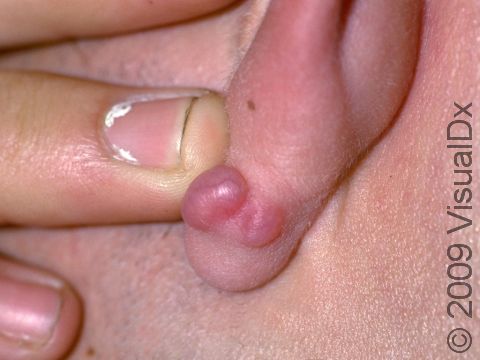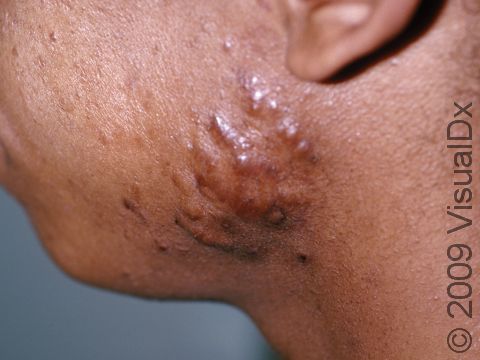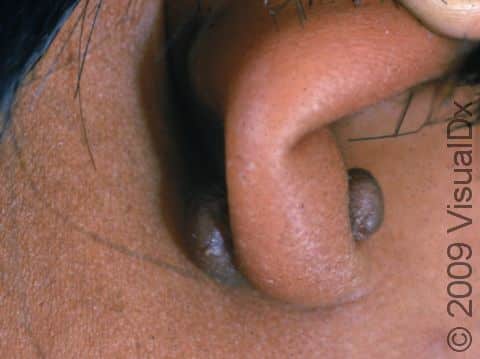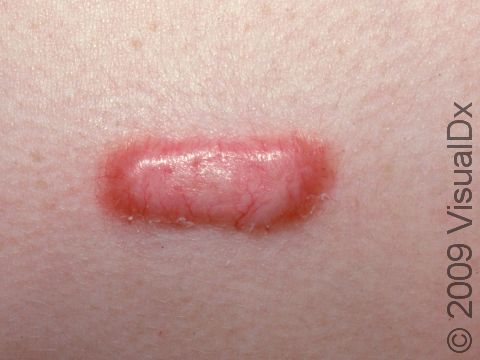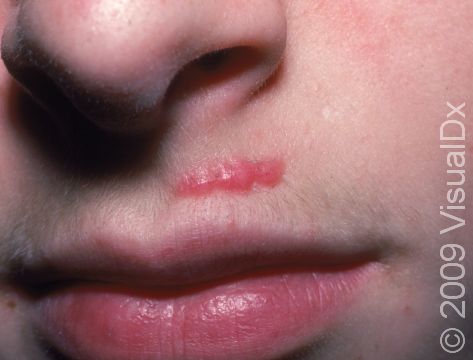Keloid
Keloids are dense, thick nodules (solid, raised bumps that are firm to the touch) or plaques (raised or bumpy areas larger than a thumbnail) typically found at areas of previously injured skin (such as burns, cuts, and piercings), or they may arise spontaneously on healthy skin. Over weeks to months, keloids can become painful, tender, and itchy, and they can grow to become very large, up to 30 cm. They can be cosmetically bothersome, and people with keloids often seek removal.
Who's At Risk?
- Keloids affect people of all ages, including young children, but most individuals start developing keloids after puberty.
- Keloids can appear in people of every race / ethnicity.
- The areas of the skin that are prone to keloid formation include the neck, ear lobes, legs, arms, and upper trunk. If you have a keloid, you are at risk of more keloids forming in these areas whenever the skin is injured.
Signs & Symptoms
Keloids are usually seen on the neck, ear lobes, legs, arms, and on the upper trunk, especially the chest. They frequently occur where there was a previous injury. Keloids that appear spontaneously on healthy skin are common on the middle of the chest.
- Keloids are smooth and shiny, firm to the touch, and have regular or irregular ridges.
- In lighter skin colors, keloids are often skin-colored, pink, or reddish. In darker skin colors, they are skin-colored or any shade of brown.
- Keloids may grow beyond the original area of injury.
Self-Care Guidelines
No self-care is necessary for keloids, but it is important to avoid unnecessary trauma, such as skin piercings. Some keloids respond to silicone sheeting (eg, Nuvadermis Scar Sheets) applied to the skin on an ongoing basis for months. The sheeting may soften and flatten the keloid somewhat, although usually not completely.
Treatments
Keloids are difficult to treat, but your child’s health professional may try the following:
- Silicone gel sheeting, if not previously used.
- There has been some success in treating small earlobe keloids with pressure or “clip-on” earrings.
- Keloids often respond to steroid injections into the keloid. There is a risk of skin lightening (hypopigmentation) with steroid injections.
Alternative therapies include:
- Freezing (cryosurgery) plus steroid injections.
- Surgery followed by steroid injections to the affected area. Note, however, that surgical removal of keloids may lead to the keloid coming back (recurring) larger than it was before the excision, and repeated steroid injections may be needed to prevent this complication.
- Laser therapy with a pulsed-dye laser for lesions that are actively growing / enlarging.
Visit Urgency
Seek medical evaluation if your child’s keloids become bothersome or symptomatic (eg, itchy or painful).
References
Bolognia J, Schaffer JV, Cerroni L. Dermatology. 4th ed. Philadelphia, PA: Elsevier; 2018.
James WD, Elston D, Treat JR, Rosenbach MA. Andrew’s Diseases of the Skin. 13th ed. Philadelphia, PA: Elsevier; 2019.
Kang S, Amagai M, Bruckner AL, et al. Fitzpatrick’s Dermatology. 9th ed. New York, NY: McGraw-Hill Education; 2019.
Paller A, Mancini A. Paller and Mancini: Hurwitz Clinical Pediatric Dermatology. 6th ed. St. Louis, MO: Elsevier; 2022.
Last modified on February 27th, 2023 at 7:50 pm

Not sure what to look for?
Try our new Rash and Skin Condition Finder
